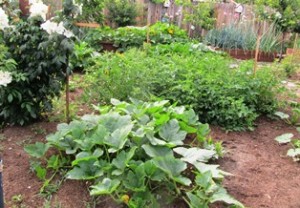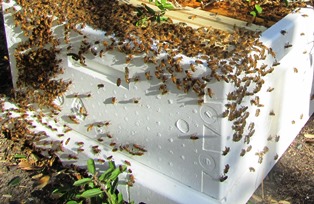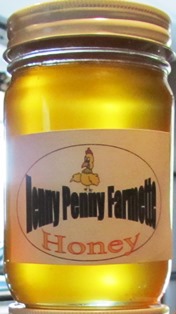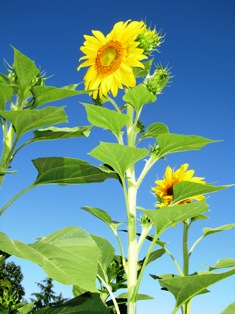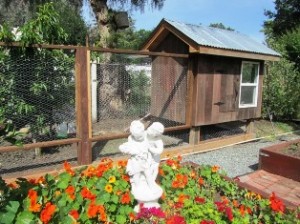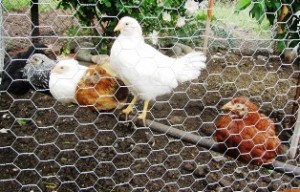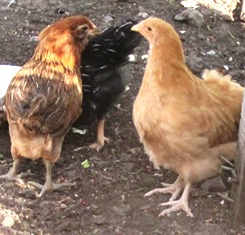Archive for May, 2014
Twelve Reasons to Grow Your Own Food
Doctors tell us we should eat fruits and vegetables for our health. Fresh is best. For more reasons to grow your own food, read on.
1. Enjoy Superior Flavor and Higher Nutritional Value
The flavor of produce that travels from your edible garden to your plate is far superior to that of store-bought varieties. Even before fresh produce reaches the bins of your local store, the fruits and vegetables must be picked, sorted, crated, and transported from suppliers t0 supermarkets and grocery stores. Time spent in transporting and storage can diminish food flavors and nutrient values.
2. Keep It Pesticide-Free
Go organic. Choose alternative methods (companion planting and organic sprays, for example) to treat garden pests and plant diseases. Organic farming starts with nourishing the soil, which in turn, nourishes the plants that nourishes a healthy body. Organically grown fruits and vegetables picked fresh, immediately prepared, and served are nutritionally superior than their commercially grown and stored counterparts.
3. Safeguard Your Health
Avoid the cancer-causing agents and toxic chemicals in pesticides that are commonly used on many commercially grown food products.
4. Cultivate Plant Diversity; Preserve History
Grow varieties of the vegetables and fruits you love. Or, choose cultivars that might have grown in your grandmother’s garden–a nod to preserving history. Or, plant varieties that have fallen out of favor, are unusual, or are even rare.
5. Lower Your Food Bill
Grow your own edibles and preserve them for later consumption (like freezing spring peas for a fall or winter meal). Preserving the bounty by drying or freezing or canning can reduce your grocery bills. Another cost and time saver is to grow hard-to-find varieties of heirloom herbs, vegetables, or fruits instead of tracking down sources for those items.
6. Expand Your Knowledge of Plants
Understanding the seed-to-harvest cycle in nature fosters deep appreciation for ecology and the environment and contributes to your knowledge about various plants’ needs for nutrients, water, light, and temperature. You also learn about treatment options for garden-variety pests and plant diseases. This wealth of information can be shared with younger generations who will inherit the responsibility of caring for the planet.
7. Get Exercise
You can still work out, albeit in the garden in the fresh air rather than in an indoors gym. Think about all the exercise you’ll get digging, planting, shoveling, watering, weeding, and composting. Gardening provides plenty of solid exercise and rejuvenates a weary spirit.
8. Reduce Your Stress
Time spent in a garden is restorative: it nourishes your spirit and reduces stress levels. In fact, just a few moments of deep breathing and thinking about birdsong, sunshine, fresh air, and healthy plants all around you–nature in all its splendor–can generate a positive mental attitude.
9. Alleviate Concerns about Food Safety and Quality
You know the quality of the food you bring from your edible garden to the table. You want the superior freshness, flavor, and food quality for your loved ones. The chances for food-borne illnesses of the kind that strike Americans every year and are often investigated by the Centers for Disease Control (CDC) are vastly diminished when you grow organic edibles and eat them as fresh as possible.
10. Preserve Our Planet’s Diversity
Choose seeds that are open-pollinated, non-GMO (genetically modified organism; the result of scientists engineering or modifying the genetic material of food plants). It may come as no surprise that the health of our nation has declined with the demise of small family farms even as there’s been a rise in the number of supermarkets and expansion of modern agribusiness. It’s no wonder people everywhere are getting behind buy-local, keep-it-local movements; participating in farmers’ markets, and engaging in urban homesteading where self-reliance is paramount.
11. Earn Extra Money
Selling your home-grown produce to others in your community means you can make possible the goodness of organic produce to others while earning a little money (hint: buy more seeds or otherwise reinvest in your garden).
12. Feel Good about Donating Excess Produce to a Food Bank
Your local food bank or (sometimes churches, too) will distribute donated produce to needy families. Let it be a source of joy for you that your gardening efforts have literally put food in the mouths of those in less fortune life circumstances.
Jars, Lids, Bottles, and Stoppers
Our world-class neighborhood beekeeper checked my hives on Sunday and told me that potentially, I could have 100 pounds of honey to harvest during the flow this year. Each frame will produce roughly 40 pounds of honey and each hive holds 10 frames.
If the hive is robust and extenders (additional boxes of frames) have been added, they may also hold honey, although a good beekeeper never takes all the honey. The bees have to eat, too.
It was pretty clear that I need to get some jars. Lucky for me, he and his wife already have found a good supplier. The company they use is located in the Bay Area.
Today, she and I traveled headed toward Oakland, a drive of about 45 minutes, to where Saxco International operates its corporate offices and huge warehouse at 155 98th Avenue in Oakland. See, http://www.saxco.com.
Jars aren’t the only type of packaging the company offers. From wine, spirits, beer, and vinegar bottles and stoppers; pharmaceutical containers; bar glassware that can be monogrammed or labeled; and food jars and lids, this company’s offerings are impressive.
We waited close to an hour for the warehouse worker to load the plastic-wrapped cases onto a pallet, drive the forklift over to her truck, and load the whole shebang onto the bed. Although the boxes towered above the cab, we made it home with no problems.
And just when I was feeling optimistic about being better prepared to deal with all that honey, it occurred to me that I’m going to need a lot of cheesecloth to strain it, buckets to drain it, and labels for all those jars!
Could a honey separator be in my future? I’m beginning to think that beekeeping could become an expensive hobby. Ah, but a sweet one: honey never goes bad and the honeybees pollinate my fruit trees, which are loaded with fruit. Next on my list–jam jars.
Crafts You Can Make from Your Backyard Garden
Invariably, when fall and winter holidays roll around each year, I find myself wishing that I’d planned ahead and utilized more raw materials from the garden for gift-giving. If you have had a similar experience, here are some ideas for turning what you grow into heart-warming gifts.
At summer’s end, harvest the seeds of your favorite flowers like cosmos, sunflowers, nasturtiums, zinnias, and even vegetables. Dry and re-package into paper envelopes that you hand-stamp, emboss, or otherwise embellish for gift-giving. Be sure to include information about how to grow the plant.
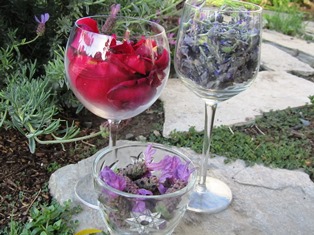
Rose petals, Spanish lavender, and French perfume lavender can be used to make a flower essences or potpourri
Flowers and herbs, picked at their zenith, can be turned into potpourri, fragrant soaps, soothing lotions, and skin moisturizers.
If you keep bees in your backyard garden, consider using the extra wax for dipping candles. Of course, honey is highly prized for its healthful properties, so be sure to jar up plenty of honey for gift-giving occasions.
Vines, berries, and pine cones are easily transformed into wreaths and dry arrangements.
A bottle of vodka, gin, or other spirits can be transformed into a gourmet gift by the addition of sun-ripened berries, herbs, vegetables (such a cucumber), or fruits and then stored in a dark, cool place for at least six weeks.
Gourds make lovely bird feeders and bird houses.
Just imagine the delight a dried-pepper wreath, a garlic braid, or jars of dried beans and seeds might evoke.
Make sheets of homemade paper, incorporating colorful rose petals, lavender, or pansies. Making paper is easy if you have a blender, some scraps of paper (junk mail works), and water.
Seed cakes, created from crunchy peanut butter, seeds, nuts, and dried fruit, make great gifts for bird lovers who can place them near feeders during the cold months when the bird must vigorously forage for food.
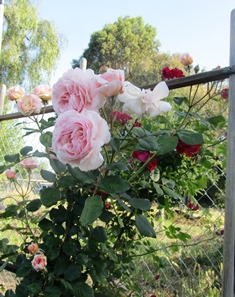
Re-potted cuttings of your garden favorites make lovely gifts for other gardeners in your family or circle of friends
Take cuttings in fall or early spring from your roses, dip the cuttings into root hormone, and plant the cuttings into a pot of soil that you keep damp until the roots have formed. Or dig bulbs (bearded irises, for example) and place in a tin for gift-giving.
Preserve jars of pie-filling, do up crocks of pickles, or create mouth-watering chutneys and special relishes. Wrap the jar lids in gingham and ribbon. Use hot-water canning of fruit and citrus into jam, jelly, and marmalade. Place jars of these items into a food basket, made festive with the addition of colorful tea towels or tissue paper and ribbon.
Use clean, dry corn husks for tamale-making, or craft them into corn husk dolls.
With a little forethought and advance planning, you’ll have plenty of backyard bounty to harvest and turn into gifts for almost any holiday or special occasion.
Growing Peaches in Northern California
What could be more sublime that eating a juicy, ripe peach freshly plucked from the tree? If you have space in your Northern California backyard or garden, consider planting one or more peach trees.
In the Bay Area, peaches are fairly easy to grow. Depending on the cultivar, they are heavy bearing. We planted a classic gold Elberta and some early-bearing Desert Gold peaches two years ago. Already, both trees are loaded with peaches.
I ate a Desert Gold peach off the tree today. It was ripe on one side and still a little crunchy on the other. Another week, and they’ll all be ready for a cobbler. The Elberta peaches will not be ripe until late July or early August.
Peaches are best eaten fresh, in my opinion. But they also freeze well or you can make them into jam, preserve them with spices, or blend up a batch of chutney or baby food. Your best bet is to plant peach trees during bare root season because they are cheaper and more plentiful then. Right now (second week of May), nurseries have replanted their bare root trees into pots.
One of my favorite nurseries in the Bay Area is Alden Lane Nursery in Livermore, California. The nursery carries hundreds of fruit and nut trees and thousands of roses. The oak trees on the property are 300 years old and one has a community of honeybees dwelling in the tree. It’s a great time to visit the nursery. For a list of offers, see http://www.aldenlane.com/media/softprogram.pdf.
Peaches need a lot of sunshine, high nitrogen fertilizer, and water to perform optimally. They also suffer from peach leaf curl, a fungus that can be easily treated with a fixed-copper spray. Dormant oil will control scale if they get it. The trees will live for 15 to 20 years.
Prolific producers, peaches need fruit thinning early on to yield larger fruit and avoid branch breakage. See the University of California’s Master Gardener program tip sheet for more information at http://homeorchard.ucanr.edu/Fruits_&_Nuts/Peach/.
If you love peaches, it’s not too late to plant a tree in your backyard for a bountiful crop of late spring/summer fruit.
Dealing with a Flock of Stressed-Out, Feathered-Out Chicks
Now that the weather has turned warm here in Northern California, I have moved my baby chicks from the huge box in my kitchen to our newly constructed chicken house. I don’t know for certain, but I think they were feeling stressed out in the box and I was stressed from the noise and their behaviors of pecking each other and trying to fly out of the box.
The hen house has two windows that open and close for ventilation, nesting boxes, a front door for my access, a back exit door with stairs for the chickens to enter and leave, and a couple of perches inside and out. We wired a poultry screen over the top of the chicken run because of the predatory habits of local hawks.
Our chicks range in age from eight and ten weeks and are all feathered out. I feed them medicated crumble and provide fresh water daily. To ensure strong legs, I cover the chicken house floor with a bed of dried, crushed corn cob. I also have stuffed straw into the three nesting boxes so that when the chickens are ready to begin laying, they’ll have a bed ready.
The chicks are growing so fast, their girth and height seems to double every week. The bulk of their diet is crumble, but with an occasional treat such as shredded fresh lettuce and spinach leaves. Their activities and often-flighty behaviors are notable for chickens. They take dust baths, scratch the earth for grubs and worms, run at each other while seemingly intent on crashing only to avert at the last minute, perch together to roost, and peck their housemates. Oh, the pecking!
Guess which chicken is the most aggressive pecker from my flock that includes White Leghorn, Silver-Laced Wyandotte, Buff Orpington, Rhode Island Red, Black Sex Link, and an Ameraucana. Turns out,in my flock, the most aggression is shown by the Buff Orpington.
From day one, “Buffy” has pecked the quiet Ameraucana. Before the Ameraucana had feathered out, blood would flow from her back from Buffy’s senseless pecking. I tried to separate them, giving Buffy time outs and hoping to stop her behavior. It seemed to work . . . or, maybe I was just imagining it was.
I placed a dab of antibiotic cream on the back of the Ameraucana and within days, her pecking wound healed and now she’s feathered again over the wound. The move to the chicken house reduced the stress of living out of a box in the kitchen. Now the chickens seem to get along fine, even enjoying their life in the hen house.
Last night, Buff huddled up next to the Ameraucana on the roost and this morning I saw the two of them taking a dust bath together. Chicken stress relief. My stress relief. It’s a beautiful thing!
 Facebook
Facebook Goodreads
Goodreads LinkedIn
LinkedIn Meera Lester
Meera Lester Twitter
Twitter





